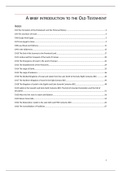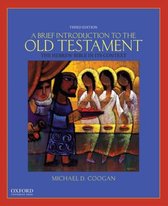A BRIEF INTRODUCTION TO THE OLD TESTAMENT
INDEX
CH4 The Formation of the Pentateuch and the Primeval History.............................................................................2
CH5 The ancestors of Israel.......................................................................................................................................4
CH6 Escape from Egypt.............................................................................................................................................5
CH7 From Egypt to Sinai............................................................................................................................................9
CH8 Law, Ritual and Holiness..................................................................................................................................11
CH9 In the wilderness..............................................................................................................................................15
CH10 The End of the Journey to the Promised Land..............................................................................................17
CH11 Joshua and the Conquest of the Land of Canaan..........................................................................................20
CH12 The Emergence of Israel in the Land of Canaan............................................................................................24
CH13 The Establishment of the Monarchy..............................................................................................................29
CH14 The reign of David..........................................................................................................................................33
CH15 The reign of Solomon.....................................................................................................................................36
CH16 The Divided Kingdoms of Israel and Judah from the Late Tenth to the Early Eight Centuries BCE...............40
CH17 The Northern Kingdom of Israel in the Eight Century BCE............................................................................44
CH18 The Kingdom of Judah in the Eighth and Early Seventh Centuries BCE.........................................................48
CH19 Judah in the Seventh and Early Sixth Centuries BCE: The End of Assyrian Domination and the Fall of
Jerusalem.................................................................................................................................................................51
CH20 After the Fall: Jews in Judah and Babylon......................................................................................................56
CH21 Return from Exile...........................................................................................................................................59
CH22 The Restoration: Judah in the Late Sixth and Fifth Centuries BCE.................................................................62
CH23 The Consolidation of Traditions.....................................................................................................................67
1
,CH4 THE FORMATION OF THE PENTATEUCH AND THE PRIMEVAL HISTORY
OTHER STRATEGIES FOR INTERPRETING THE PENTATEUCH
Form criticism: the study of the smaller units within each units. As this brief description indicates, form
criticism and other methods used in connection with it recognize that the Pentateuchal sources were
not constructed out of nothing, as it were: they used pre-existing traditions.
Redaction criticism: how are the sources combined? Many scholars conclude that there was creative
design at this stage.
Inner-biblical interpretation: focusing on the final form, not just of the Torah, but of the Bible as a
whole.
PRIMEVAL HISTORY
J (THE YAHWIST SOURCE)
We will consider episodes where the two sources, J and P, are distinct and we will look to the Flood, where they
are combined.
In the J source in Genesis 4-11, three interrelated themes can be identified:
The deteriorating relationship between humans and the soil: J tells us how the originally harmonius
relationship (Adam was made out of soil) was broken by the disobedience of the man and woman.
The divinely ordained separation of the divine from the human realms: God banished Adam and Eve
from the garden, so that they could no longer have access to the three of life and become immortal
and thus fully divine.
The progressive corruption of humanity: The disobedience of Adam and Eve was followed by the
murder by Cain and the building of the first city by Cain’s increasingly violent descendants.
T HE G ENEALOGIES IN J
Most of the genealogies in Genesis belong to P, but at intervals they appear in J, which are mixed genealogies,
that include narrative fragments in addition to list of descendants.
P (THE PRIESTLY SOURCE)
T HE G ENEALOGIES IN P
There are two P narratives (creation and the flood), but the rest of the P material consists of genealogies. In this
genealogies it is shown that the human life spans diminished: P documents the J theme of growing divine
displeasure with human wickedness. Ancient parallels exist both to the extraordinary life spans of primeval
humans and to the diminishing length of those life spans, for example the Sumerian King List.
THE FLOOD
In the narrative of the Flood are both the two sources, J and P, recognized.
T HE J V ERSION
The use of the divine name Adonai
Typically vivid anthropomorphism, for example Adonai’s closing of the door of the ark after all had
boarded.
2
,T HE P V ERSION
Detailed instructions about the construction of the Ark
The covenant with Noah
Use of God (Elohim)
ANCIENT NEAR EASTERN PARALLELS
Part of the Gilgamesh epic is an account of the Flood, as told by Utnapishtim. The story was widespread in the
ancient Near East, there are versions of the tale written many centuries before biblical Israel existed.
Close connections are found between the biblical and non-biblical accounts:
Divine anger
The hero is warned by a god of a Flood about to occur
He is given detailed instructions about building a boat
The hero releases three birds.
This parallels make clear that the accounts of the Flood belong to the genre of myth. Beside, no geological
evidence has been found for a worldwide deluge.
The rainbow alludes to the battle between the storm-god and the primeval chaotic sea: the storm-god has set
his terrible weapon in the clouds, so that it will not be used again.
3
,CH5 THE ANCESTORS OF ISRAEL
One of the principal themes of the ancestral narrative in Genesis is that of exile and return under divine
guidance and protection.
Form criticism: looking at the earlier units and traditions that the Pentateuchal sources adapted and
incorporated into their narratives.
Tradition history: how were the sources combined into larger units?
Redaction criticism: how were the different parts shaped into their final form?
THE J SOURCE IN GENESIS 12-50
Most of the narratives concerning the ancestors of Israel in Genesis 12-50 belong to the J-source.
The threefold promise of land, descendants and blessing: each part of these promises is fulfilled in a
complex and indirect way.
Sexuality is more explicit than in other versions.
THE E SOURCE IN GENESIS 12-50
E features places of importance in the northern kingdom of Israel.
Jacob acquires land near Schechem by purchase, rather than by violence as in J.
Dreams, e.g. God tells Abimelech that Abraham is married to Sarah.
Etiology: the sacrifice of Isaac, in which also the theme ‘fear of God’ is included.
THE P-SOURCE IN GENESIS 12-50
Lists of the descendants of Abraham through Ishmael en Isaac and Esau.
‘Be fruitful and multiply’ is a characteristic phrase.
Accounts of marriages, births and deaths.
Circumcision as a sign of a covenant with Abraham.
FORM CRITICISM
This method of observing elements of earlier traditions is developed by Hermann Gunkel. Form criticism begins
by identifying a form/genre, e.g. the etiological narrative (a tale whose function is to explain the origin of a
name, geographical feature or a religious custom) An example of this genre is the change of Abram’s name to
Abraham.
Different passages show parallels with each other, e.g. ‘the childless woman’ (Sarah, Rebekkah, Rachel, etc.)
Another example: clothing is a means of deception in the cycle of stories concerning Jacob (p. 70 for
explanation).
ANCIENT NEAR EASTERN PARALLELS
The childless Kirta gets divine instructions to prepare an expedition to obtain a wife. He carries out the
instructions and vows to Asherah, a goddess, that he will present her gold and silver if the journey is successful.
The journey is and the marriage is blessed by the gods: soon he produces sons and daughters.
Parallels with Genesis:
Childless ancestors
4
, Divine promise of offspring
A journey for a wife
A vow is made
The birth of children.
THE UGARITIC TEXTS
The discovery of the Ugaritic texts by Schaeffer was one of the most important of the 20 th century for
illuminating the larger context in which the Hebrew Bible was written.
THE JOSEPH NARRATIVE
This narrative is seen as a part belonging to the E source, because of 1) dreams and 2) Northern Kingdom
(Schechem). The alternate view is that this narrative was an independent literary composition.
Few details can be correlated with Egyptian sources, but no mention of Joseph, son of Jacob, as an Egyptian
official is found in any Egyptian records.
THE ANCESTORS OF ISRAEL
The Patriarchs: Abraham, Isaac and Jacob
The Matriarchs: Sarah, Rebekkah, Rachel and Leah (all at some stage are unable to conceive children).
The sons of Jacob
GENEALOGIES
One social convention that recurs in the ancestral narratives is endogamy: marriage within one’s ethnic, cultural
or religious community. This was essential for the survival of the community’s identity, but despite the cultural
preference for endogamy, however, the patriarchs often married outside the group: Abraham took Hagar, Esau
took his wifes among the Canaanites, Joseph married Asenath. The genealogies are expressions of relationships
between groups. They also explain how one group became more powerful than another.
HISTORY AND THE ANCESTORS OF ISRAEL
The quest for historicity is complicated by several factors:
1. Biblical chronology for this period is unreliable, note especially the long life spans attributed to the
ancestors.
2. Because many stages of composition and editing have shaped the narratives, the stories often contain
elements that don’t fit in the time the stories were written in.
3. Because of the use of different sources in the final form of the narrative, many inconsistencies are
found.
Given the lack of non-biblical correlations, scholars think that the entire narrative is a historical fiction written
late in the biblical period. The period in which Israel’s ancestors lived is dated as early as the mid-third
millennium BCE to as late the early first.
THE RELIGION OF THE ANCESTORS
The word ‘El’ can be used of any deity. ‘El’ was among others known as the chief god of the Canaanite
pantheon. This was also the god of Abraham, Isaac and Jacob.
CH6 ESCAPE FROM EGYPT
5






